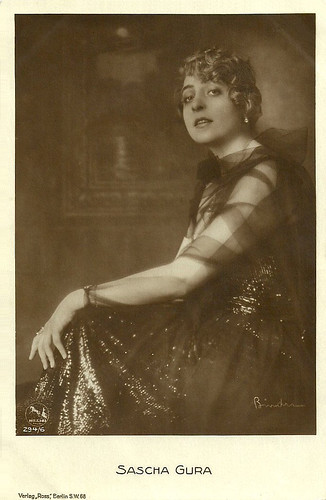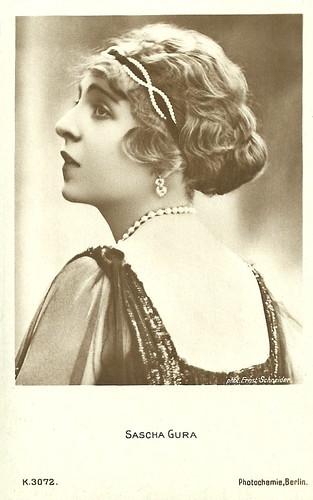Around 1920, Sascha Gura (1896-?) was highly popular and active in the silent cinema of the Weimar Republic. She is particularly memorable in a few expressionist horror films by Otto Rippert and F.W. Murnau. After the rise of the Nazis, the Jewish actress disappeared in oblivion.

German postcard by Ross Verlag, Berlin, no. 294/1. Photo: Alex Binder / Decla.
Sascha Gura was born in Munich, Germany in 1896 as Eugenia Theresia Gura. She was the daughter of the singer and actor Hermann Gura and granddaughter of singer and actor Eugen Gura.
Sascha had her professional training at the Königliche Hochschule für Musik (Now Universität der Künste Berlin). Her career started as operetta singer during the First World War and from 1921 on she became successful at the Komische Oper in Berlin.
Gura became a film actress in 1919, debuting in the expressionist silent film Der Totentanz/Dance of Death (Otto Rippert, 1919), a Helios Film production, scripted by Fritz Lang. Gura played the lead of a dancer who kills men after seducing them by her dance. She is forced to do so by a disfigured doctor (Werner Krauss) who thus takes revenge on the world, until she meets a man (Karl Bernhard) she falls in love with.
It was followed by such films as Phantome des Lebens/Phantom of Life (Josef Coenen, 1919) with Lil Dagover, and Das Haupt des Juarez/The Head of Juarez (Johannes Guter, Rudolf Meinert, 1920) starring Eduard von Winterstein. For six years she would perform in more of such dark dramas and adventure stories.

German postcard by Ross Verlag, Berlin, no. 294/6. Photo: Alex Binder / Helios Film.
In 1920 Sascha Gura went to Vienna to perform in two films by Heinz Hanus at Astoria-Film, the adaptation Wie Satan starb/How Satan Died (Heinz Hanus, 1920) with Nora Gregor, and Unter der Knute des Schicksals/Under the Knout of Destiny (Heinz Hanus, 1921).
Memorable was Gura’s part in F.W. Murnau’s horror film Die Bücklige und die Tanzerin/The Hunchback and the Dancer (Friedrich Wilhelm Murnau, 1920), in which she played the female lead Gina, opposite John Gottowt.
Carl Mayer’s script is similar to Der Totentanz: a disfigured man takes vengeance on the world. The story also reminds Batman’s Poison Ivy. A hunchback, who has become a millionaire by finding diamonds in Java, but also learned there about mortal venoms. When Berlin dancer Gina first falls for him and then goes back to the baron she already loved before, he makes her skin mortal to anyone who kisses her. Sadly, the film is considered lost.
Then followed Die Liebschaften des Hektor Dalmore/The love affairs of Hektor Dalmore (Richard Oswald, 1921) featuring Conrad Veidt. In the next years followed more than a dozen film parts in silent films such as the female lead in Die Handschrift des Inka/The manuscript of the Inca (1925) by Gernot Bock-Stieber, with whom she had done various films before as well.
In 1927 Gura quitted acting in silent cinema, after making the action film Bezwinger der 1000 Gefahren/Conqueror of 1000 dangers (1927) directed by its star, Harry Piel. She played two small parts in sound films, in Trenck - Der Roman einer großen Liebe/Trenck (Ernst Neubach, Heinz Paul, 1932) starring Hans Stüwe, and Grüss mir die Lore noch einmal/Greet Lore for Me one more time (Carl Heinz Wolff, 1934).
Then the Jewish actress got into trouble with the Nazi regime and her career ended. We couldn't find more information on the web about her further whereabouts.

German postcard by Photochemie, Berlin, no. K 3072. Photo: Ernst Schneider.
Sources: Stephanie d'Heil (Steffi-line.de - German), Filmportal.de, Wikipedia (German) and IMDb.

German postcard by Ross Verlag, Berlin, no. 294/1. Photo: Alex Binder / Decla.
Seducing By Dance
Sascha Gura was born in Munich, Germany in 1896 as Eugenia Theresia Gura. She was the daughter of the singer and actor Hermann Gura and granddaughter of singer and actor Eugen Gura.
Sascha had her professional training at the Königliche Hochschule für Musik (Now Universität der Künste Berlin). Her career started as operetta singer during the First World War and from 1921 on she became successful at the Komische Oper in Berlin.
Gura became a film actress in 1919, debuting in the expressionist silent film Der Totentanz/Dance of Death (Otto Rippert, 1919), a Helios Film production, scripted by Fritz Lang. Gura played the lead of a dancer who kills men after seducing them by her dance. She is forced to do so by a disfigured doctor (Werner Krauss) who thus takes revenge on the world, until she meets a man (Karl Bernhard) she falls in love with.
It was followed by such films as Phantome des Lebens/Phantom of Life (Josef Coenen, 1919) with Lil Dagover, and Das Haupt des Juarez/The Head of Juarez (Johannes Guter, Rudolf Meinert, 1920) starring Eduard von Winterstein. For six years she would perform in more of such dark dramas and adventure stories.

German postcard by Ross Verlag, Berlin, no. 294/6. Photo: Alex Binder / Helios Film.
Poison Ivy
In 1920 Sascha Gura went to Vienna to perform in two films by Heinz Hanus at Astoria-Film, the adaptation Wie Satan starb/How Satan Died (Heinz Hanus, 1920) with Nora Gregor, and Unter der Knute des Schicksals/Under the Knout of Destiny (Heinz Hanus, 1921).
Memorable was Gura’s part in F.W. Murnau’s horror film Die Bücklige und die Tanzerin/The Hunchback and the Dancer (Friedrich Wilhelm Murnau, 1920), in which she played the female lead Gina, opposite John Gottowt.
Carl Mayer’s script is similar to Der Totentanz: a disfigured man takes vengeance on the world. The story also reminds Batman’s Poison Ivy. A hunchback, who has become a millionaire by finding diamonds in Java, but also learned there about mortal venoms. When Berlin dancer Gina first falls for him and then goes back to the baron she already loved before, he makes her skin mortal to anyone who kisses her. Sadly, the film is considered lost.
Then followed Die Liebschaften des Hektor Dalmore/The love affairs of Hektor Dalmore (Richard Oswald, 1921) featuring Conrad Veidt. In the next years followed more than a dozen film parts in silent films such as the female lead in Die Handschrift des Inka/The manuscript of the Inca (1925) by Gernot Bock-Stieber, with whom she had done various films before as well.
In 1927 Gura quitted acting in silent cinema, after making the action film Bezwinger der 1000 Gefahren/Conqueror of 1000 dangers (1927) directed by its star, Harry Piel. She played two small parts in sound films, in Trenck - Der Roman einer großen Liebe/Trenck (Ernst Neubach, Heinz Paul, 1932) starring Hans Stüwe, and Grüss mir die Lore noch einmal/Greet Lore for Me one more time (Carl Heinz Wolff, 1934).
Then the Jewish actress got into trouble with the Nazi regime and her career ended. We couldn't find more information on the web about her further whereabouts.

German postcard by Photochemie, Berlin, no. K 3072. Photo: Ernst Schneider.
Sources: Stephanie d'Heil (Steffi-line.de - German), Filmportal.de, Wikipedia (German) and IMDb.
No comments:
Post a Comment